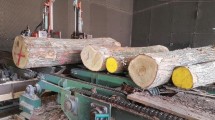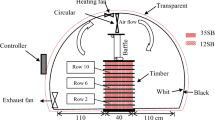Abstract
In specific cases, kiln drying prior to preservative treatment is the prescribed method of utility pole seasoning in South Africa. The slow drying nature of Eucalyptus grandis poles makes rapid kiln drying potentially detrimental due to development of defects such as excessive surface checking, honeycomb and collapse. To control these defects while maintaining the fastest drying rate possible, the effect of drying schedule on the drying quality of E. grandis poles was investigated. Full length pole drying was simulated in thirty 2.1 m long butt sections of poles of which the top ends were end sealed. Three industrially used schedules that differed in dry and wet bulb temperature and duration of drying (T db, T wb and time) were chosen: 80°C/59°C/8 days, 80°C/69°C/10 days and 70°C/59°C/12 days. Surface check length of each pole was measured after drying. Cross-sections cut at the theoretical ground line (TGL), 1.5 m from the butt end, were used to measure the moisture content (MC) gradient between the shell and core of poles. Digital image analysis of cross-sections of discs cut at TGL was used to measure the area of honeycomb and disc cross-section. Collapse was assessed qualitatively.
With all three schedules, MC's in the pole cores at the end of drying were still very high. Some poles were above 25% in the outer 25 mm of the treatable zone. The 70°C/59°C/12 days schedule generated the highest surface check total length. A reduction in the wet bulb depression of the 80°C dry bulb schedules from 21 to 11°C, accompanied by a simultaneous increase in drying time, did not reduce honeycomb or collapse. With a wet bulb depression of 11°C, a slight reduction in honeycombing was observed when T db was reduced from 80 to 70°C. From this preliminary study it can be concluded that at 80°C T db, poles should be dried longer than 8 days and that T db's lower than 80°C should be considered to minimise potentially serious drying defects.
Zusammenfassung
In bestimmten Fällen ist in Südafrika vor der Schutzmittelbehandlung die Durchführung einer technischen Trocknung von Strommasten vorgeschrieben. Eucalyptus grandis Masten trocknen langsam, wodurch eine schnelle technische Trocknung zu Trocknungsfehlern, wie zum Beispiel exzessive Oberflächenrisse, Innenrisse und Kollaps, führen kann. Um diese Fehler bei schnellstmöglicher Trocknungsgeschwindigkeit zu minimieren, wurde in dieser Studie der Einfluss des Trocknungsprogramms auf die Trocknungsqualität von E. grandis Masten untersucht. Anhand von dreißig 2,1 m langen und an den Stirnenden versiegelten Stammabschnitten wurde eine Trocknung ganzer Masten simuliert. Drei industriell angewendete Trocknungsprogramme mit unterschiedlichen Trocken- und Feuchttemperaturen und unterschiedlicher Trocknungsdauer (T db, T wb und Zeit) wurden ausgewählt: 80°C/59°C/8 Tage, 80°C/69°C/10 Tage und 70°C/59°C/12 Tage. Nach der Trocknung wurde an jedem Masten die Länge der Oberflächenrisse gemessen. An Scheiben, die im theoretischen Boden-Luft-Bereich (TGL) 1,5 m vom unteren Stammende entnommen wurden, wurde der Holzfeuchtegradient im Mastquerschnitt bestimmt. Mittels digitaler Bildanalyse der im Boden-Luft-Bereich entnommenen Scheiben wurden die Fläche der Innenrisse und der Mastquerschnitt gemessen. Kollaps wurde qualitativ bestimmt. Die Holzfeuchte im Masteninneren war bei allen drei Programmen nach der Trocknung immer noch sehr hoch. Bei einigen Masten lag sie in den äußeren 25 mm des imprägnierbaren Bereichs über 25%. Die höchste gesamte Oberflächenrisslänge ergab sich bei dem Programm 70°C/59°C/12 Tage. Eine Absenkung der Feuchttemperatur des Programms mit 80°C Trockentemperatur von 21 auf 11°C bei gleichzeitig längerer Trocknungsdauer führte zu keiner Reduzierung von Innenrissen oder Kollaps. Bei einer Absenkung der Feuchttemperatur auf 11°C wurde eine leichte Reduzierung von Innenrissen beobachtet, wenn die Trockentemperatur von 80 auf 70°C gesenkt wurde. Aus dieser Vorstudie kann geschlossen werden, dass bei einer Trockentemperatur von 80°C die Masten länger als 8 Tage getrocknet werden sollten, und dass eine Trockentemperatur unter 80°C zur Minimierung möglicher schwerwiegender Trocknungsfehler in Betracht gezogen werden sollte.






Similar content being viewed by others
References
ESI Africa (2000) Wood utility poles: are standards relevant. Scarborough Productions international (Pty) Ltd.http://www.esi-africa.com/lastESI22000-013-1.htm. Accessed 5 June 2006
Graham RD, Womack RJ (1972) Kiln- and Boulton-drying Douglas-fir pole sections at 220° to 290°F. Forest Prod J 22(10):50–55
Hill BP, Bekker A, Bailey MN (2003) Specification for wood poles, cross-arms and spacer blocks. ESKOM Distribution Standard, Germiston, South Africa
Mackay JFG, Oliveira LC (1989) Kiln operator's handbook for Western Canada. Forintek Canada Corp., Vancouver
Mugabi P (2007) Moisture content and drying defects in kiln-dried Eucalyptus grandis poles. PhD Forestry (Wood Science) dissertation, Stellenbosch University, South Africa. McGraw-Hill Book Company, New York
Pratt GH (1974) Timber drying manual. McCorquodale Printers Ltd, London
Rice RW (1994) Drying stresses: causes and solutions. In: Profitable solutions for quality drying of softwood and hardwoods. Proceedings of the conference sponsored by the Forest Products Society, Madison, 25–27 March 1994
Rypstra T, Wessels CB, Steinmann D, Vermaas HF (2004) Durability improvement of wooden utility poles: determination of moisture content gradients in air-dried and kiln-dried Eucalyptus poles. South African Wood Preservers Association Interim report 2. Stellenbosch University
Simpson WT, Boone RS (1997) Kiln schedules. In: Simpson WT (ed) Dry kiln operator's manual. Forest Products Society, Madson, pp 133–177
Stöhr HP (1977) The seasoning of South African grown Eucalyptus grandis and E. saligna sawn timber. S Afr For J 102(9):61–66
Stöhr HP (1982) A study of kiln drying characteristics of E. grandis poles. CSIR contract report. National Timber Research Institute, Pretoria
Tiemann HD (1941) Collapse in wood as shown by the microscope. J Forest 39(3):271–283
Vermaas HF, Neville CJ (1988) Low temperature drying of Eucalyptus grandis. A preliminary laboratory evaluation. Holzforschung 40(4):265–271
Wangaard FF (1950) The mechanical properties of wood. John Wiley and Sons, Inc., New York
Ward JC, Simpson WT (1997) Drying defects. In: Simpson WT (ed) Dry kiln operator's manual. Forest Products Society, Madison, pp 257–267
Wessels CB, Mugabi P, Rypstra T, Steinmann D, Vermaas HF (2004) Durability improvement of wooden utility poles. South African Wood Preservers Association (SAWPA) interim report 1. Stellenbosch University
Yang JL (1998) An attempt to reduce collapse through introducing cell-wall deformations. Wood Fiber Sci 30(1):81–90
Acknowledgements
The study was made possible by support from Bedson PTY Ltd, the Norwegian Agency for Development (NORAD) through Makerere University, Uganda, and the South African Wood Preservers Association (SAWPA). We also thank Messrs. A. Kunneke and W. Hendrikse for their technical contribution during data collection.
Author information
Authors and Affiliations
Corresponding author
Rights and permissions
About this article
Cite this article
Mugabi, P., Rypstra, T., Vermaas, H.F. et al. Effect of kiln drying schedule on the quality of South African grown Eucalyptus grandis poles. Eur. J. Wood Prod. 69, 19–26 (2011). https://doi.org/10.1007/s00107-009-0392-3
Received:
Published:
Issue Date:
DOI: https://doi.org/10.1007/s00107-009-0392-3




